Water damage is one of the leading causes of costly home repairs—and often, it doesn’t end when the water is gone. Mold can begin to grow within just 24 to 48 hours of a water event. If you’re not properly covered, this can lead to thousands in out-of-pocket expenses.
What Is a Mold Rider?
A mold rider is an optional endorsement you can add to your homeowners insurance policy. It’s designed to provide limited mold coverage, typically for mold that results from a covered water loss, like a burst pipe or accidental overflow.
But here’s where things get tricky…
Mold Coverage Only Applies if the Water Loss Is Covered
Even if you have a mold rider, your insurance only helps if the source of water damage is something your policy covers. That means:
✅ Covered: A dishwasher hose bursts, flooding your kitchen. You act quickly, but mold forms behind the cabinets. Your mold rider may apply.
🚫 Not Covered: Mold develops over time from poor ventilation, high humidity, or a slow roof leak that’s been ongoing. These are usually considered maintenance issues—and not covered.
Mold Riders Have Coverage Limits
Another important point: even if you’re covered, most mold riders come with caps. The most common limits are:
- 💵 $2,500 to $5,000 in mold coverage
- 💵 Some policies may offer up to $10,000, but that’s rare and usually comes at a higher premium
These limits apply to everything—remediation, reconstruction, and sometimes even content replacement. That doesn’t go far if you have mold in walls, ceilings, HVAC systems, or personal belongings.
Why Mold Coverage Matters
Mold isn’t just a nuisance—it’s a potential health hazard. Prolonged exposure can lead to:
- Respiratory irritation
- Headaches and fatigue
- Skin rashes
- Worsened symptoms for asthma and allergy sufferers
The faster you act after water damage, the lower the chance of mold spreading—and the less you’ll have to fight with insurance to get it covered.
What Should Homeowners Do?
✅ Review Your Policy – Look for any mold exclusions or limits
✅ Know Your Coverage Limits – Don’t assume you’re protected for the full cost
✅ Add a Mold Rider if You Don’t Have One – It’s relatively inexpensive and worth the protection
✅ Call MSI Immediately After Water Damage – We respond fast, dry out properly, and document every step to protect your claim
✅ Don’t Delay Remediation – Mold caused by slow response time may be denied under your policy
Trusted by Homeowners Since 1998
At MSI, we’ve helped thousands of homeowners across Pennsylvania, New Jersey, and Delaware handle water damage and mold issues the right way—from emergency dry-outs to comprehensive mold remediation.
We work with all major insurance companies, provide proper documentation, and never cut corners—because your health and your home deserve better.
When water strikes, mold is just around the corner.
Call MSI right away to stay ahead of the damage—and the insurance headaches.









